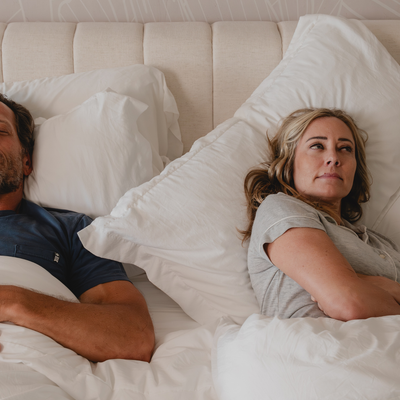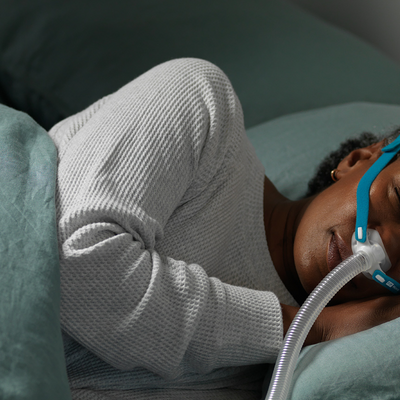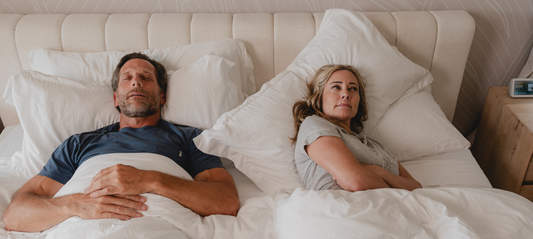Written by Nancy Kirk
June 17, 2025
We all know the feeling of looking in the mirror after a poor night’s sleep: puffy eyes, dull skin, maybe even a few extra forehead lines. But what happens when sleep loss becomes chronic, and tied to an underlying condition like obstructive sleep apnea (OSA)? Can it actually change your facial appearance over time?
According to new research, the answer is yes. Untreated sleep apnea doesn’t just affect your internal health; it can be visible on your face. And just as important: CPAP therapy may help reverse some of those changes. Let’s explore how sleep apnea impacts the way you look, and how treatment with CPAP can help you wake up feeling and appearing more refreshed.
A Study on Sleep Apnea, CPAP, and Facial Appearance
While these symptoms have previously been observed anecdotally, a University of Michigan study was the first to officially explore the connection between sleep apnea treatment and facial appearance.
Researchers used advanced 3D technology to capture precise facial images of 20 adults with sleep apnea before and after two months of CPAP therapy. The participants had moderate to severe OSA and reported excessive daytime sleepiness. These pre- and post-treatment images were then evaluated by 22 independent raters, who were unaware of which images were taken before or after therapy.
-
68% of raters thought the post-CPAP images looked more alert
-
64% said they felt they looked more youthful
-
67% rated them as more attractive
In other words, treating sleep apnea didn’t just improve how people felt, it changed how they looked, in a way that was noticeable even to strangers.
How Sleep Apnea Can Affect Facial Appearance
Obstructive sleep apnea causes your airway to repeatedly collapse during sleep, depriving your body of oxygen and fragmenting your sleep cycle. The result is chronic fatigue, cardiovascular strain, and an increased risk for a host of health conditions. But sleep apnea also takes a toll on your physical appearance in ways people don’t often talk about. Here are some of the most common visible effects:
1. Under-Eye Puffiness and Swelling
Sleep apnea can lead to fluid retention, especially around the face and neck. This can cause puffiness under the eyes and a swollen, tired appearance, similar to what you'd see after a long night of poor sleep, but more persistent.
2. Facial Redness and Inflammation
OSA is associated with chronic inflammation, which can manifest in the skin as redness, particularly around the cheeks and under the eyes. This contributes to a flushed or irritated look, even when you’re not aware of any other symptoms.
3. Deeper Forehead Wrinkles and Eye Droop
Surprisingly, untreated sleep apnea can cause muscle tension in the face. People with OSA may unconsciously raise their eyebrows to keep their heavy eyelids open, which, over time, can lead to deeper forehead lines and drooping eyelids.
4. Dull Skin and Poor Complexion
Interrupted sleep limits your body’s ability to regenerate skin cells and maintain healthy circulation. Over time, this can lead to a dull, uneven complexion and even accelerate the visible signs of aging.
CPAP Therapy & Facial Appearance
The study also documented several measurable changes in facial features using digital imaging:
-
Reduced Forehead Volume: Researchers found a significant decrease in forehead tissue volume post-treatment, which may be linked to reduced nighttime fluid retention or facial muscle relaxation.
-
Less Redness Around the Eyes and Cheeks: Facial redness associated with inflammation was noticeably decreased after consistent CPAP use, especially under the eyes and in the cheek area.
-
No Significant Change in Eye Openness (Ptosis): Contrary to common belief, there was no consistent change in eyelid drooping, but some subjective improvements were still noted in alertness.
These findings support the idea that CPAP therapy not only restores proper sleep and oxygen levels but also reduces systemic inflammation and improves circulation, both of which contribute to a healthier, more vibrant appearance.
With that said, CPAP therapy can pose some skin challenges, like dryness or irritation, especially when you first get used to your mask. If you can relate, check out Sleep Apnea and Facial Health: Skin Care Tips for CPAP Therapy.
The Emotional Impact of CPAP Therapy
We often focus on the internal benefits of treating sleep apnea, such as reduced risk of heart disease, stroke, diabetes, and cognitive decline. But appearance can be just as motivating for patients! Let’s face it: we’re hardwired to respond to facial cues. Looking tired can influence how others perceive your mood, energy, and even competence. In professional and social settings, this perception holds significant importance.
More importantly, when patients see tangible improvements in their appearance, it can reinforce adherence to CPAP therapy. Just as we’re more likely to stick to a diet when we see weight loss, we’re more likely to wear a CPAP mask when we see ourselves looking more refreshed and confident.
This insight is crucial for clinicians. If a patient is struggling with motivation, sharing before-and-after images or studies like this one may help reframe therapy as something with visible, immediate payoffs, not just distant health benefits.
READ: How Your Diet Affects Sleep Apnea: Foods to Include & Avoid
Sleep Better, Look Refreshed With Lofta
At Lofta, we make it easy to take that first step with our at-home sleep apnea test. No labs, no overnight stays, just quick, comfortable testing from your own bed. And if you're already using a CPAP? Know that consistent nightly use isn’t just restoring your sleep; it could also be subtly restoring your appearance.
The face you present to the world reflects how you feel on the inside. Sleep apnea may subtly age your appearance over time, but CPAP therapy offers more than just health benefits; it also provides visible rejuvenation.
At Lofta, we’re here to help you every step of the way, from diagnosis to CPAP setup, troubleshooting, and beyond. With advanced testing and the latest in sleep tech, you can finally get the rest your body (and skin) deserves.










































